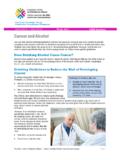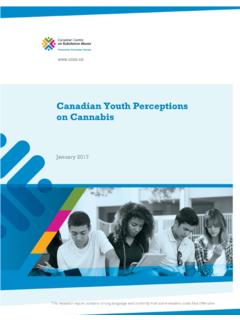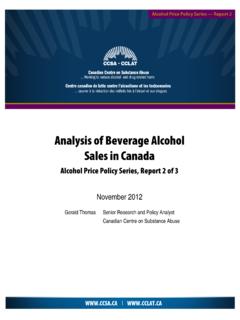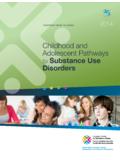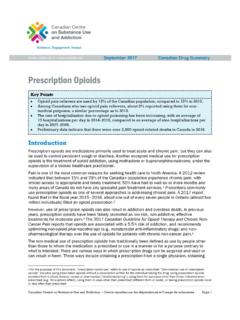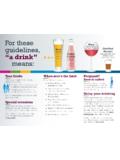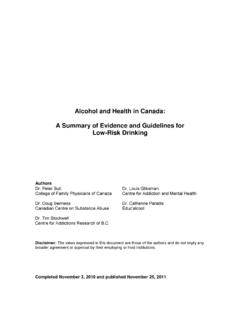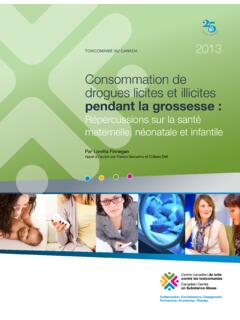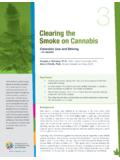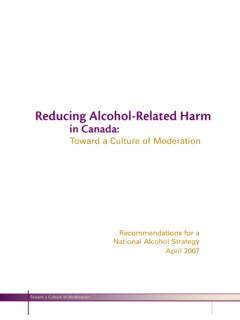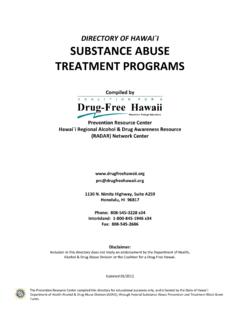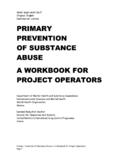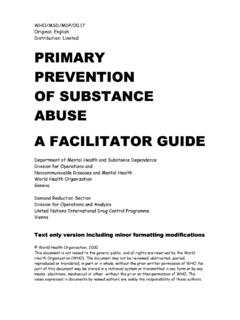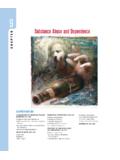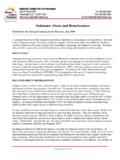Transcription of Substance Abuse in Canada: Youth in Focus
1 Substance Abuse in Canada: Youth in FocusSeptember 2007 CANADIAN CENTRE ON Substance ABUSEThis document was published by the Canadian Centre on SubstanceAbuse (CCSA) and was made possible in part through a financialcontribution from Health canada . The views expressed herein donot necessarily reflect the views of Health citation: Canadian Centre on Substance Abuse . (2007). Substance Abuse in canada : Youth in Focus . Ottawa, ON: CanadianCentre on Substance 2007 by the Canadian Centre on Substance Abuse (CCSA). All rights additional copies, contactCCSA, 75 Albert St., Suite 300 Ottawa, ON K1P 5E7 Tel.: 613-235-4048 Email: document can also be downloaded as a PDF at document est galement disponible en fran ais sous le titre :Toxicomanie au canada : Pleins feux sur les jeunesISBN 1-897321-58-9 Introduction.
2 2 Substance use and harm in the general Youth population ..4 Angela Paglia-Boak, (Psych.) and Edward Adlaf, Reviewed by St phane Racine, , and Jillian Flight, use among non-mainstream M. Saewyc, , RN, PHNR eviewed by Dr. Valerie Gideon, responses to Youth Substance Brochu, by Catherine McPherson-DoeDrug Abuse , addiction and Youth : a neuroscience perspective ..30 Franco Vaccarino, by Marco Leyton, in our approaches to Youth Substance use and Abuse ..38 Grant Charles, and Carla Alexander, by Jane Fjeld, : A call to action ..46 Table of contentsSubstance Abuse in canada : Current Challenges and Choiceswasfirst published in 2005 as a way of drawing attention to a series ofkey contemporary issues in Substance Abuse in canada , and theirimplications for policy development.
3 The first edition looked at awide range of topics from newdirections in preventing alcoholproblems to alternative sanctions for cannabis use and possession,and from drugs and driving to diversion and Abuse of prescriptionmedications. Every chapter concluded with a discussion of impli-cations and potential future directions for Canadian substanceabuse planning for a second edition of Substance Abuse in canada ,theCanadian Centre on Substance Abuse once again consulted with avariety of Substance Abuse and addiction experts to identify theissues of greatest concern in 2007. What emerged was a list of topicsuggestions that seemed to have a single unifying theme: Youth whether it was concern about the age of initiation for first-timealcohol and drug use (now around 14 or younger), the unusuallyhigh levels of cannabis use among young Canadians compared withtheir peers in other countries, or the rise in hazardous drinking bythose under examination of patterns of Substance use and related harmswithin the Canadian population sends a clear message: Youth deserve2 Canadian Centre on Substance AbuseINTRODUCTIONa special Focus .
4 This was the rationale for including children andyouth in one of three priority areas in the National Framework forAction to Reduce the Harms Associated with Alcohol and OtherDrugs and Substances in canada . Young people are the most likelyto use substances, engage in risky forms of use, and experienceharms as a result. As well, early experience with Substance use andhazardous patterns of drug-using behaviour during adolescenceare serious risk factors for developing long-standing problems,including dependence, that continue into adulthood. Risk factors for problematic Substance use also overlap with riskfactors for other negative outcomes such as criminal and violentbehaviour.
5 Prevention programs that target Substance Abuse alsohave the potential to forestall the development of these otherbehaviours. Successful treatment of Substance use problems at anearly age substantially lowers the risk of long-term harms, includingchronic diseases. Intervening with Youth offers the best chance tonot only have a positive influence on their future development asindividuals, but also to reduce the impact of Substance Abuse onsociety as a this edition of Substance Abuse in canada , we look at the issueof Youth Substance use and Abuse from several perspectives: Substance use and harm in the general Youth populationAdolescence and young adulthood is a period of biological, intel-lectual, and psychosocial development.
6 Many lifelong skills andbehaviour patterns are established during this time. The use ofalcohol and illicit drugs typically begins during adolescence. Formost, this use is experimental or occasional, but a substantialminority will experience harm to their current or subsequenthealth, or threaten the well-being of others. This chapter examinesthe prevalence of Substance use and Abuse among canada smainstream Youth population (defined here as ages 12-24), aswell as consequential use among non-mainstream youthWhile most adolescents do not have Substance Abuse problems,certain groups of Youth are more likely than their peers to reportheavy use, multi-drug use, social and economic problems due touse, and Substance Abuse or dependence disorders.
7 Emergingresearch exploring the reasons for this higher risk suggests thatsome teens may be self-medicating to cope with toxic environments,untreated trauma, and underlying psychological population approaches for preventing adolescent druguse may not address the key issues for groups at highest risk, butmay only reach the majority who are not likely to experiencesubstantial harms from drug responses to Youth Substance Abuse In North America, and more specifically in canada , it is nowrecognized that Substance Abuse is a major health care problemthat entails substantial economic costs. Statistics generally showthat the periods when the prevalence of alcohol and other drug useand Abuse is highest are late adolescence and young chapter looks at canada s response to Youth Substance abusefrom a four pillars perspective comprising prevention, treatment,enforcement and harm reduction.
8 It also examines the different rolesthat schools and communities play in addressing Youth substanceabuse and suggests how those roles could be better Abuse , addiction and Youth : a neuroscience perspectiveThis chapter provides insights into the biological basis of drugabuse and addiction. Although drug Abuse and addiction are oftenperceived as behaviours controlled by individual choice and freewill, it is also true that drugs produce physical and chemicalchanges in the brain that make it progressively harder to act on adesire to quit. Adolescence is a time of brain development and theinadvertent short-term and long-term biological consequences ofdrug exposure during adolescence can create harm and a long-termvulnerability to future drug effects.
9 These long-term changes maybe at the root of drug Abuse problems well into the adult in our approach to Youth Substance use and abuseLevels and quality of mental health and addiction services varyacross canada , but regardless of region or jurisdiction, there is ageneral lack of funding for age-appropriate services for youngpeople and their families. Mental health and addictions havelong been orphans in our health and human service systems, andsubstance Abuse prevention and intervention services for youngpeople receive a miniscule portion of the larger health and humanservice budget. This creates fragmentation of services and accessdifficulties, and prevents the development of a continuum ofservicesand a range of : A call to action In this concluding chapter, we draw on many of the themes exploredin earlier chapters and use these as a starting point for a discussionof future directions for the Substance Abuse field.
10 We explore theimportance of appropriately matching services to the needs of youngpeople and discuss gaps and shortcomings in services for Youth andhow we might correct them. We then address the need for improvedtraining and closer collaboration among Substance Abuse and alliedprofessionals, and highlight the value of ongoing research into riskand protective factors associated with Youth Substance Abuse andthe need for improved evaluation of Substance Abuse programs. Substance Abuse IN canada | IntroductionCanadian Centre on Substance Abuse3 Angela Paglia-Boak, (Psych.)Centre for Addiction and Mental Health (CAMH)Edward Adlaf, for Addiction and Mental Health (CAMH)Reviewed by St phane Racine, and Jillian Flight, DrugStrategy and Controlled Substances Program, Health CanadaSubstance use and harm in the general Youth populationCanadian Centre on Substance Abuse5 John, 17, went to a party on Friday night with some friends.
